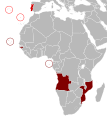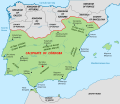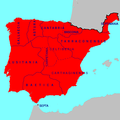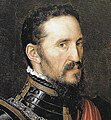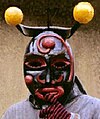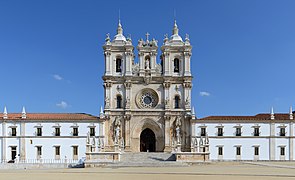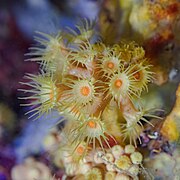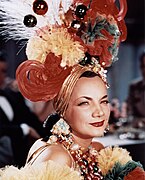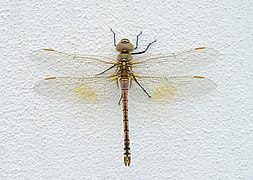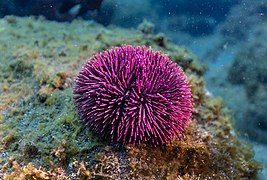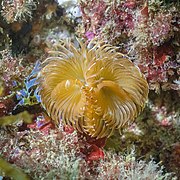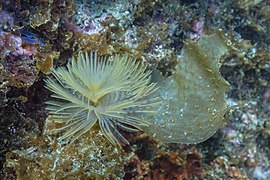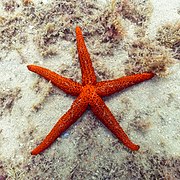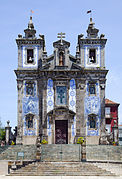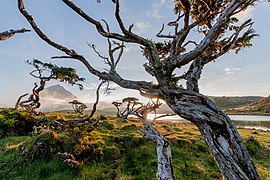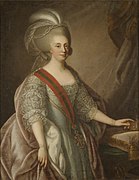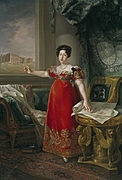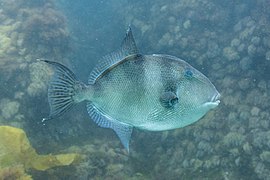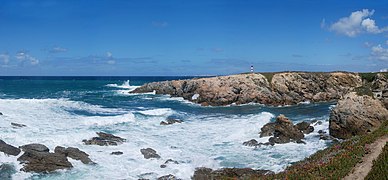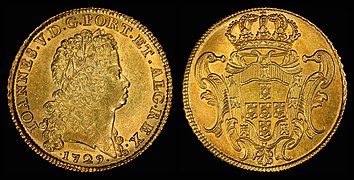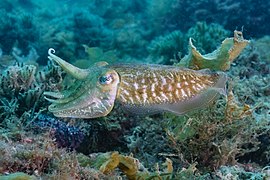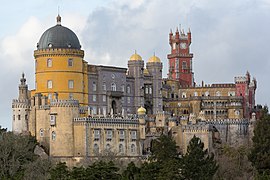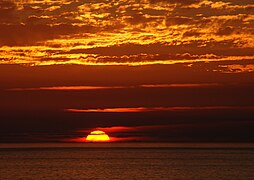Welcome to the Portugal portal  Portugal, officially the Portuguese Republic, is a country located on the Iberian Peninsula in Southwestern Europe, whose territory also includes the Macaronesian archipelagos of the Azores and Madeira. It features the westernmost point in continental Europe; its mainland west and south border with the North Atlantic Ocean; and in the north and east, the Portugal-Spain border, which constitutes the longest uninterrupted border line in the European Union. Portugal is the oldest nation-state in Europe. Founded in 1143, its current borders were established in 1297, making them some of the most ancient in Europe and the world. Its archipelagos form two autonomous regions with their own regional governments. On the mainland, the Alentejo region occupies the biggest area but is one of the least densely populated regions of Europe. Lisbon is the capital and largest city by population, and it is also the main spot for tourists alongside Porto, the Algarve and Madeira. As one of the oldest countries in Europe, its territory has been continuously settled and fought over since prehistoric times. The territory was inhabited by the Celtic and Iberian peoples. It was later ruled by the Romans, followed by the invasions of Germanic peoples together with the Alans and later the Moors, who were eventually expelled during the Reconquista. First founded as a county within the Kingdom of León in 868, Portugal formally became an independent kingdom with the Treaty of Zamora in 1143. During the Age of Discovery, particularly in the 15th and 16th centuries, Portugal established one of the longest-lived maritime and commercial empires, becoming one of the main economic and political powers of the time. By the early 19th century, events such as the 1755 Lisbon earthquake, the country's occupation during the Napoleonic Wars, and the resulting independence of Brazil in 1822 led to a marked decay of Portugal's prior opulence. This was followed by the civil war between liberal constitutionalists and conservative absolutists over royal succession from 1828 to 1834. The 1910 revolution deposed Portugal's monarchy and established the democratic but unstable Portuguese First Republic, later superseded by the authoritarian regimes of Ditadura Nacional (National Dictatorship) and Estado Novo (New State). Democracy was restored after the Carnation Revolution (1974), ending the Portuguese Colonial War and eventually losing its remaining colonial possessions. (Full article...) Selected article -Our Lady of Fátima (Portuguese: Nossa Senhora de Fátima, pronounced [ˈnɔsɐ sɨˈɲɔɾɐ ðɨ ˈfatimɐ]; formally known as Our Lady of the Holy Rosary of Fátima) is a Catholic title of Mary, mother of Jesus, based on the Marian apparitions reported in 1917 by three shepherd children at the Cova da Iria in Fátima, Portugal. The three children were Lúcia dos Santos and her cousins Francisco and Jacinta Marto. José Alves Correia da Silva, Bishop of Leiria, declared the events worthy of belief on 13 October 1930. Pope Pius XII granted a pontifical decree of canonical coronation via the papal bull Celeberrima solemnia towards the venerated image on 25 April 1946. The designated papal legate, Cardinal Benedetto Aloisi Masella, carried out the coronation on 13 May 1946, now permanently enshrined at the Chapel of the Apparitions of Fátima. The same Roman Pontiff also raised the Sanctuary of Fátima to the status of a minor basilica by the apostolic letter Luce superna on 11 November 1954. (Full article...) This is a Featured article, which represents some of the best content on English Wikipedia.
 The national flag of the Portuguese Republic is a rectangular bicolour with a field divided into green on the hoist, and red on the fly. The lesser version of the national coat of arms of Portugal (armillary sphere and Portuguese shield) is centered over the colour boundary at equal distance from the upper and lower edges. Its presentation was done on 1 December 1910, after the downfall of the constitutional monarchy on 5 October 1910. However, it was only on 30 June 1911, that the official decree approving this flag as the official flag was published. This new national flag for the First Portuguese Republic, was selected by a special commission whose members included Columbano Bordalo Pinheiro, João Chagas and Abel Botelho. The conjugation of the new field color, especially the use of green, was not traditional in the Portuguese national flag's composition and represented a radical republican-inspired change that broke the bond with the former monarchical flag. Since a failed republican insurrection on 31 January 1891, red and green had been established as the colours of the Portuguese Republican Party and its associated movements, whose political prominence kept growing until it reached a culmination period following the Republican revolution of 5 October 1910. In the ensuing decades, these colours were popularly propagandised, green represented the hope of the nation and the colour red represented the blood of those who died defending it, this happened to endow them with a more patriotic and dignified, therefore less political, sentiment. The sphere and shield in the middle of the current flag are an integral part of the design, which has historically been centred on the royal arms, usually over fields of blue and white. Since the country's foundation, the standard developed from the blue cross-on-white armorial square banner of King Afonso I, through progressively more complex designs, which did incorporate green and red, to the liberal monarchy's arms over a blue-and-white rectangle. In between, major changes associated with determinant political events contributed to its evolution into the current design. (Full article...) General imagesThe following are images from various Portugal-related articles on Wikipedia.
Selected quote -"Grenades? No... This is only smoke. Be calm, the people is serene! The people is serene!"
Granadas ? Não...Isto é só fumaça.Calma o povo é sereno!O povo é sereno! This is a Good article, an article that meets a core set of high editorial standards.
Vasco da Gama was an ironclad of the Portuguese Navy built in the 1870s by the Thames Iron Works in London. Ordered to strengthen the defenses of the Portuguese capital of Lisbon, Vasco da Gama was launched in 1875 and completed in 1878. She served as the flagship of the Portuguese fleet for the majority of her long and peaceful career. She was rebuilt and heavily modernized between 1901 and 1903. Her crew was involved in revolts in 1913 and 1914; during the latter event, they bombarded Lisbon and killed around one hundred people. Long-since obsolete by the 1930s, Vasco da Gama was finally sold for scrapping in 1935. (Full article...) Selected Biography -D. Vasco da Gama, 1st Count of Vidigueira (/ˌvæsku də ˈɡɑːmə, - ˈɡæmə/ VAS-koo də GA(H)M-ə; European Portuguese: [ˈvaʃku ðɐ ˈɣɐmɐ]; c. 1460s – 24 December 1524), was a Portuguese explorer and nobleman who was the first European to reach India by sea. His initial voyage to India by way of Cape of Good Hope (1497–1499) was the first to link Europe and Asia by an ocean route, connecting the Atlantic and the Indian oceans. This was a milestone in Portuguese maritime exploration as and marked the beginning of a sea-based phase of globalization. Da Gama's discovery of the sea route to India opened the way for an age of global imperialism and enabled the Portuguese to establish a long-lasting colonial empire along the way from Africa to Asia. Traveling the ocean route allowed the Portuguese to avoid sailing across the highly disputed Mediterranean Sea and traversing the dangerous Arabian Peninsula. The sum of the distances covered in the outward and return voyages made this expedition the longest ocean voyage ever made until then. (Full article...) Selected picture - The Assembly of the Republic (Portuguese: Assembleia da República) is the Portuguese parliament; its building in Lisbon is referred to as São Bento Palace (Saint Benedict's Palace).
Did you know -
Portugal topicsPortugal lists
SubcategoriesRecognized content
Featured articlesFormer featured articlesFeatured listsFormer featured listsGood articles
Former good articlesDid you know? articles
Featured pictures
Former featured portalsIn the News articles
Main page featured articles
Picture of the day pictures
Featured topicsNew articlesThis list was generated from these rules. Questions and feedback are always welcome! The search is being run daily with the most recent ~14 days of results. Note: Some articles may not be relevant to this project.
Rules | Match log | Results page (for watching) | Last updated: 2024-10-19 21:38 (UTC) Note: The list display can now be customized by each user. See List display personalization for details.
Things you can doRelated PortalsRelated WikiProjects
Associated WikimediaThe following Wikimedia Foundation sister projects provide more on this subject:
Discover Wikipedia using portals |


![Image 1Maios celebration in Madeira island [1] (from Culture of Portugal)](http://upload.wikimedia.org/wikipedia/commons/thumb/e/e1/2011-03-05_03-13_Madeira_045_Santana_%285543431418%29.jpg/120px-2011-03-05_03-13_Madeira_045_Santana_%285543431418%29.jpg)













